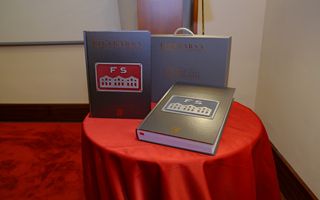(Finance) – “Pietr’Arsa from workshop to railway museum“: this is the title of first publication made by FS Italiane Foundation which collects and organizes the documentation, photos and testimonies found so far in the National Railway Museum of Pietrarsa. The work, presented this morning by General Director of the FS Luigi Cantamessa Foundation and from curator Stefano Maggi, it is an in-depth study of images and drawings, but also of reading and research, which celebrates the history of the workshops, their restoration and valorization, proposing itself as a reference publication.
A unique place in Italy, overlooking the Gulf of Naples, the National Railway Museum of Pietrarsa contains a significant piece of the country’s history. In 1840, the Royal Mechanical and Pyrotechnic Factory of Pietrarsa was founded here by King Ferdinand II of Bourbon, which became the largest industry in the Kingdom of the Two Sicilies and one of the most important after national unification. In 1839, the first railway on the peninsula was inaugurated in this area, connecting Naples to Granatello di Portici.
The Italian Railways therefore have chosen a symbolic place to preserve and disseminate its cultural heritage: the first factory and repair shop on the first national railway route. The book is divided into three sections: Pietrarsa as it was, Pietrarsa becomes a FS museum, Pietrarsa is reborn, each of which retraces a historical period concerning respectively the 135 years of life of the workshop, the first set-up of the museum and the recent relaunch completed by FS Foundation, which gave new life and new cultural horizons to the entire complex.
In the first years the factory, managed by the military, became the largest industry in the Kingdom of the Two Sicilies, but also in the Kingdom of Italy in the first years after March 1861, following thenational unification. Its fame spread far beyond the borders of the South and from the initial period the Pietrarsa factory was the subject of illustrious visits, from the Tsar of Russia Nicholas I to Pope Pius IX.
At the basis of this book is careful research on the workshops in their 135 years of life, from 1840 to 1975, with the attempt to create a precise reconstruction not only of the events, but also of the context in which they developed. This part, which could be defined as the life of the production, is followed by a meticulous analysis of subsequent museum developments, which since 1989 have led the ancient factory to become the National Railway Museum, definitively relaunched in recent years by the FS Italiane Foundation.
The parable of the Pietrarsa workshops concerns the history of the Italian railways, but also fully enters into the debate between libertarians and protectionists, which developed in the first decade of life of the new unified kingdom, when the adoption of the low customs tariffs of the Kingdom of Sardinia put many factories in the other pre-unification states in crisis. Pietrarsa then enters into industrial policies and labor issues, with the scientific organization known as Taylorism and trade union affairs. It is also related to the themes of corporate welfare brought by the railway Dopolavoro and the complex technical history of locomotives. Finally, it belongs to museology and industrial archaeology, due to the importance it has within both disciplines.
The museum today is not just a tourist attraction, but a point of reference for those who want to learn about the Italian railway tradition. Every perfectly restored steam, diesel or electric locomotive and every railcar present in Pietrarsa reflect the design, operation and development of the Italian railways.
After much work for the restoration of the museum and following its success and the appreciation received from experts, enthusiasts, families, young people, foreigners and Italians, today Pietrarsa is a finished work. To celebrate this feat it was necessary to treasure all the books, historical documents and guides published over the years, conferring with personalities of railway culture, authors and scholars to create “The Book of Pietrarsa”.
The work is available in four different editions: Collection volume with plaque and slipcase, published by DUEGI Editrice, printed in a limited edition of 80 numbered and signed copies; Luxury volume with dust cover published by DUEGI Editrice; Economic version published by Rubbettino and Audiobook available for purchase on the most important online distribution platforms, at the corner shop of the Pietrarsa Museum and the Online Shop of the FS Foundation.
